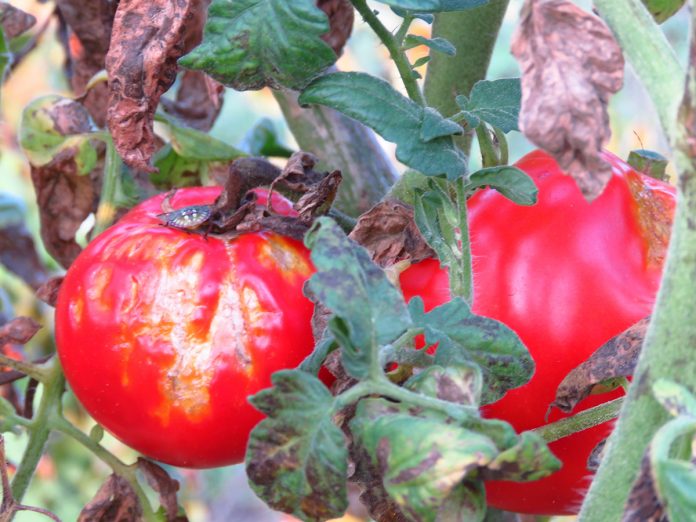Didier Andrivon from INRA underlines late blight and organic crops, including solving the arduous copper equation
Organic farming is on the rise and so is the consumers’ demand for organic products. Part of its rapid expansion in Europe is due to the ‘pesticide-free’ image of organic systems, and hence their expected benefits for agrosystems and human health, especially for products like fruit and vegetables. Unfortunately, the situation is not quite so simple and organic production does not entirely escape the pesticide debate.
What is the oomycete Phytophthora infestans?
Late blight of potatoes and tomatoes, caused by the oomycete Phytophthora infestans, is a widespread disease causing severe problems in conventional agriculture, but even more so for organic growers. Indeed, organic farming does not have the array of chemical solutions that conventional growers can still use.
The most efficient ‘organic-approved’ pesticide against late blight remains copper and its derivatives – notably the famous ‘Bordeaux mixture’ of grapevine fame, which is now used globally and expected to continue to rise in coming years (Deane, 2019). But copper has also strong drawbacks: it is toxic to a wide range of organisms – including soil microbiota, earthworms and aquatic species, it can accumulate to high concentrations in topsoil when used frequently and hence, compromise long-term soil fertility, the preservation of which is a core goal of organic farming. Furthermore, copper products do not match one of the key requirements of organic systems, that is to avoid the use of synthetic inputs.
They are allowed in organic agriculture mainly because they are considered as ‘traditional’ solutions, although they are actually rather recent (the Bordeaux mixture was invented by Millardet in the 1880s) and are industrial products produced through synthetic chemistry.
These shortcomings have led to increasing restrictions on copper use in organic systems. Although copper was re-approved as a plant protection active ingredient at the European Union (EU) level in 2018, the maximum dose applicable to crops was lowered from 6 to 4 kg per hectare and per year on a seven-year moving average basis. Some countries, mainly in northern Europe, have entirely forbidden copper use for crop protection purposes (in both conventional and organic systems) owing to its adverse effects on soil and water quality, while several organic certification bodies and some practitioners of organic farming (notably those promoting biodynamic systems) also impose that copper must not to be used.
What are the alternatives to copper?
To tackle this major issue, the search for alternatives to copper has been and still is, very active.
Three main options are investigated:
Biocontrol, that is the use of natural means to regulate pest populations. This includes biological control (in this case, using antagonistic or hyperparasitic microbes already present in nature), but also natural biocides (plant extracts, microbial metabolites and even ‘basic substances’, such as vinegar or salts) and plant defense stimulators. Many candidate preparations for biocontrol of late blight have been tested, and a number of them provided satisfactory efficacy under controlled conditions. Unfortunately, the transfer of this biological performance to field conditions is still problematic, and very few of these preparations have made it to the market and can be used as copper substitutes by growers to date;
Resistant cultivars are the cornerstone of copper-free crop protection systems in organic farming. The catalogue of resistant cultivars available in Europe is quite extensive, although most currently registered varieties of potato and tomato, and particularly the most popular ones, are susceptible or very susceptible to late blight. Switching to resistant cultivars seems easy, but is in practice faced with many difficulties: the supply for planting material is not always sufficient (organic growers need to use organically grown seed), consumer or end-user preferences do not always match the agronomic and organoleptic characteristics of resistant cultivars, and cultivar turn-over is long in crops like potato, multiplied through tubers rather than seeds.
Agronomic practices, such as sanitation (seed certification for health, elimination of pathogen infection sources in or close to production fields), longer rotations or physical protection against infections (through rain covers for instance), have all demonstrated field efficacy, but are costly and sometimes technically difficult to implement. This is why, despite their clear value to control late blight outbreaks, they remain marginal in current crop protection systems.
Is there a silver bullet?
As demonstrated in a recent and extensive review of the existing scientific literature (Andrivon et al., 2018), coping without copper in organic crop protection cannot rely on a single, ‘silver-bullet’, ‘one-size-fits-all’ substitution strategy. It has to involve the combination and integration of many control means, each with limited efficacy, into redesigned systems whose performance and resilience will reside in the optimal interactions between these individual components (resistant cultivars, biocontrol, prophylaxis and sanitation, etc).
This, in turn, requires a truly systemic approach, to which organic growers are fortunately much better prepared for than conventional growers, but which needs extensive experimentation and assessment.
Such systemic, long-term experiments are, however, still very rare and need to be encouraged. Their design and implementation has been one of the major goals of several European-funded research projects, such as Blight-Mop (2000-2005), Co-Free (2012-2016) and now Organic+ (launched in 2018), which all aimed or aim at providing lasting, integrated and validated solutions for copper-free protection of organic potato and tomato crops. Thanks to such projects, much progress has been made, but many efforts are still needed to develop tailor-made solutions adapted to each grower’s situation.
References
Andrivon D., Bardin M., Bertrand C., Brun L., Daire X., Fabre F., Gary C., Montarry J., Nicot P., Reignault P., Tamm L., Savini I., 2018. Can organic agriculture cope without copper for disease control? Synthesis of the collective scientific assessment report, INRA (France), 64 p. Downloadable from http://institut.inra.fr/en/Objectives/Informing-public-policy/Scientific-Expert-Reports/All-the-news/Can-organic-farming-manage-without-copper#
Deane D., 2019. Bordeaux Mixture market 2019 research report with growth analysis, latest trends and forecasts till 2025. http://topnewsherald.com/2019/09/11/bordeaux-mixture-market-2019-research-report-with-growth-analysis-latest-trends-and-forecasts-till-2025/
*Please note: This is a commercial profile











